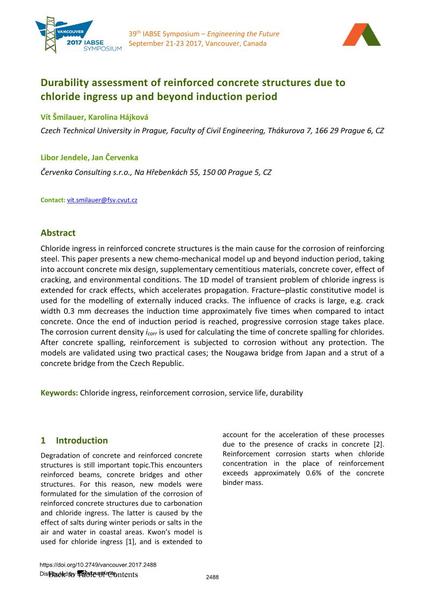Durability assessment of reinforced concrete structures due to chloride ingress up and beyond induction period

|
|
|||||||||||
Bibliographic Details
| Author(s): |
Vít Šmilauer
(Czech Technical University in Prague, Faculty of Civil Engineering, Thákurova 7, 166 29 Prague 6, CZ)
Karolina Hájková (Czech Technical University in Prague, Faculty of Civil Engineering, Thákurova 7, 166 29 Prague 6, CZ) Libor Jendele (Červenka Consulting s.r.o., Na Hřebenkách 55, 150 00 Prague 5, CZ) Jan Červenka |
||||
|---|---|---|---|---|---|
| Medium: | conference paper | ||||
| Language(s): | English | ||||
| Conference: | IABSE Symposium: Engineering the Future, Vancouver, Canada, 21-23 September 2017 | ||||
| Published in: | IABSE Symposium Vancouver 2017 | ||||
|
|||||
| Page(s): | 2488-2495 | ||||
| Total no. of pages: | 8 | ||||
| Year: | 2017 | ||||
| DOI: | 10.2749/vancouver.2017.2488 | ||||
| Abstract: |
Chloride ingress in reinforced concrete structures is the main cause for the corrosion of reinforcing steel. This paper presents a new chemo-mechanical model up and beyond induction period, taking into account concrete mix design, supplementary cementitious materials, concrete cover, effect of cracking, and environmental conditions. The 1D model of transient problem of chloride ingress is extended for crack effects, which accelerates propagation. Fracture–plastic constitutive model is used for the modelling of externally induced cracks. The influence of cracks is large, e.g. crack width 0.3 mm decreases the induction time approximately five times when compared to intact concrete. Once the end of induction period is reached, progressive corrosion stage takes place. The corrosion current densityicorr is used for calculating the time of concrete spalling for chlorides. After concrete spalling, reinforcement is subjected to corrosion without any protection. The models are validated using two practical cases; the Nougawa bridge from Japan and a strut of a concrete bridge from the Czech Republic. |
||||
| Keywords: |
durability service life reinforcement corrosion Chloride ingress
|
||||
